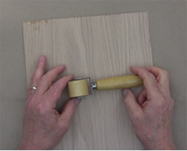 Loading... Please wait...
Loading... Please wait...Wood Veneer Tutorials
Wood Veneer How-To Videos
Gluing Wood Veneers
Gluing Wood Veneers
By Bob Morgan, Pres., Veneer Factory Outlet.com
Hello, I’m Bob Morgan, founder of Bob Morgan Woodworking Supplies and the Veneer Factory Outlet.com. Today we’re going to talk about the 3 most common methods to glue wood veneers in place.
The 3 most common ways to glue wood veneers down are:
- Use veneers that come with a self stick, 3M peel and stick adhesive.
- Use 2 coats of contact cement on both surfaces.
- Use woodworker’s glue, such as Titebond 2, and apply pressure with clamps.
The 1/64" paper backed veneers and the 3/64" wood backed veneers can be glued down with woodworker's glue or contact cement. They can also be ordered with the 3M peel and stick adhesive.
I like the peel and stick method the best because it is fast and easy and there is no mess, no clean up, no fumes, and the 3M peel and stick adhesive sticks like crazy. Please note: We do not recommend that the peel and stick veneer be used on walls or on areas larger than 24" x 96".
PSA Veneers:
 The paper backed veneers and the wood backed veneers can be ordered with the 3M peel and stick adhesive.
The paper backed veneers and the wood backed veneers can be ordered with the 3M peel and stick adhesive.
The peel and stick adhesive sticks well to a painted or varnished surface that is clean and smooth. If the surface that you are veneering isn't already painted or varnished, you must first apply a couple of coats of paint or varnish.
Hint: For a very superior bond, instead of coating the surface with 2 coats of paint or varnish, coat the surface to be veneered with 1 or 2 coats of contact cement.
 Cut the veneer a little larger than the surface that you are veneering. This allows you to trim off the excess later for an exact fit. A half inch of excess is usually fine. Just peel off the release paper and stick the veneer down. I usually like to start at one end, but sometimes I work from the center out. Just make sure that the veneer is lined up correctly and then lay it down smoothly and evenly.
Cut the veneer a little larger than the surface that you are veneering. This allows you to trim off the excess later for an exact fit. A half inch of excess is usually fine. Just peel off the release paper and stick the veneer down. I usually like to start at one end, but sometimes I work from the center out. Just make sure that the veneer is lined up correctly and then lay it down smoothly and evenly.
Sometimes, such as for inset panels, you will need to cut the veneer to the exact size ahead of time. In these situations, you will have to be extra careful to lay the veneer down just right.
 Once the veneer is stuck in place, use a wallpaper seam roller to apply pressure everywhere on the surface. This helps the self stick adhesive stick to the substrate. Do not use a J roller or a rolling pin. Use a 1” wide wallpaper seam roller.
Once the veneer is stuck in place, use a wallpaper seam roller to apply pressure everywhere on the surface. This helps the self stick adhesive stick to the substrate. Do not use a J roller or a rolling pin. Use a 1” wide wallpaper seam roller.
Here is why: Let’s say that you press down with 40 pounds of pressure. The pressure will be 40 pounds across the one inch area.
If you use a a 4” J roller, the 40 pounds will get distributed across the 4” area, but the actual pressure per inch will be 10 pounds per inch.

If you use a rolling pin, the pressure will be even less per inch of surface area.
Therefore, use a 1” wallpaper seam roller, because you will be able to apply the most pressure.
Once the veneer is stuck down, trim off the excess veneer using a razor knife. Pretty easy! 10 minute video "Using Peel and Stick Veneers"
Gluing Wood Veneer With Contact Cement:
 You can glue down the paper backed veneers and the wood backed veneers with contact cement.
You can glue down the paper backed veneers and the wood backed veneers with contact cement.
Use 2 coats of contact cement on the veneer and 2 coats of contact cement on the surface that you are veneering. Let the contact cement dry between coats. It usually takes about 30 to 60 minutes for the contact cement to dry.
Contact cement can be used on bare wood, plywood, and bare MDF (medium density fiberboard), as well as some plastic laminates. Some manufacturers say that their contact cement can be used on painted surfaces. If you do this, be sure to run a test ahead of time.
I recommend that you use the best solvent based contact cement that you can find. I’m not a fan of the water based contact cements. Follow the directions on the can and work in a well ventilated area where there is no fire hazard.
First, cut the veneer a little larger than the area that you are veneering. This allows for trimming later. Sometimes, such as for inset panels, you will need to cut the veneer to the exact size. In these situations, you should be extra careful to lay the veneer down just right when you stick it in place.
Apply the first coat of contact cement to the surface to be veneered and also to the veneer itself. You can use a stiff brush, a roller, or a wide blade putty knife for this. If your substrate is wood, plywood, or MDF, it should be clean and free of dirt.
It is important to put the contact cement on as smoothly and evenly as you can. This will reduce telegraphing of unevenly applied contact cement, through the veneer itself. Let the first coat of contact cement dry before you apply the second coat. Once the second coat is dry, you are ready to stick the veneer in place.
Do not work in a cold, damp area. Work where the temperature is 60 degrees Fahrenheit or higher. Avoid humid conditions. Cold, damp or humid conditions can cause water vapor in the air to condense on the surface of the contact cement, and this can ruin the contact cement.

The contact cement sticks on contact so be careful! Lay the veneer down smoothly and evenly. Sometimes, for larger areas, this takes 2 people. I usually like to start at one end, but sometimes I work from the center out. Just make sure that the veneer is lined up correctly and then lay it down smoothly and evenly.

Once the veneer is down, go over the surface and apply liberal pressure with a 1” wallpaper seam roller. Use a wallpaper seam roller, not a J roller or a rolling pin. You get more pressure per unit area with the smaller roller area.

After you are done, use a razor knife to trim off the excess veneer for an exact fit. 18 minute video "Gluing Wood Veneer With Contact Cement"
Gluing Wood Veneer With Carpenter's Glue:
 You can use woodworker's glue to glue down the paper backed veneers and the wood backed veneers.
You can use woodworker's glue to glue down the paper backed veneers and the wood backed veneers.
For this method, you use woodworker's glue, such as Titebond 2 and you apply pressure to the glued surface overnight with clamps. Of the 3 methods, this is the best. But it can also be more difficult, especially for large areas. It is also probably the messiest.
Be especially careful not to let any glue get onto the surface of the veneer. If glue gets on the veneer, it will cause problems when you apply a finish. Hint: Keep a bowl of water and a damp rag nearby. If some glue gets on the veneer, wipe it off immediately with the damp rag.

The surface should be “raw” wood, plywood, or medium density fiberboard (MDF). The surface should be clean, free of dirt and grease. Apply a coat of woodworker’s glue to the surface that you are veneering and also to the wood veneer.
Be sure to apply a liberal coat but don’t overdo it. Too much glue can cause a weakened glue joint. Too little glue isn’t good either. You can use a brush or a roller for this.

Position the veneer on the substrate. Then, lay a piece of waxed paper on top of the veneer. The waxed paper will prevent any glue seepage from getting onto the surface of the veneer or other surfaces.

Sandwich your work piece between 2 flat boards or 2 pieces of MDF. MDF is best because it is dead flat. Once the work piece is sandwiched between the 2 boards or MDF, use clamps to apply pressure all over everywhere.
Pressure is the key. Make sure that you use enough clamps to apply pressure everywhere. The veneer should lay dead flat against the surface that you are gluing it to. If you don’t have good pressure everywhere, you can end up with an area of veneer that didn’t quite get glued down flat.

Allow the clamped assembly to cure for about 24 hours. Once the glue has cured, remove the clamps and trim off the excess veneer with a razor knife. 17 minute video "Gluing Wood Veneers With Carpenter's Glue"
Apply Wood Veneer To Both Sides Of Your Workpiece
Regardless of the gluing method, it is best to veneer both sides of your work. This keeps the work piece stable and it prevents warping. Most of my customers don’t follow this rule and they get away with it because most surfaces, such as table tops, are securely held in place.
A free floating surface, such as a cabinet door, is certainly an area that should be veneered on both sides. If you use a paper backed veneer on the top surface, use a paper backed veneer for the back surface. If you use a wood backed veneer for the top surface, use a wood backed veneer for the back surface. You can use a less expensive veneer on the back surface if you want to.
Adhesives And Finishes Do Not Mix!
When using either the contact cement or the wood glue –Be very careful not to get any adhesive on the surface of the veneer. Even a small smudge of adhesive can cause problems later when you apply a finish.
I recommend that when you use a woodworker’s glue such as Titebond 2, keep a bowl of water and a damp rag nearby to wipe off any glue that might get onto the surface of the veneer.
If you use a solvent based contact cement, keep some solvent and a rag nearby.
If you get glue or contact cement on the veneer surface, wipe it off as soon as you possibly can!
That’s it for this tutorial. I hope that this has been helpful. I’m Bob Morgan with Bob Morgan Woodworking Supplies and The Veneer Factory Outlet.com















